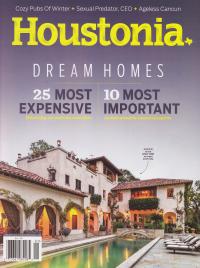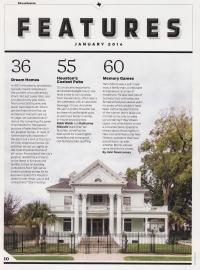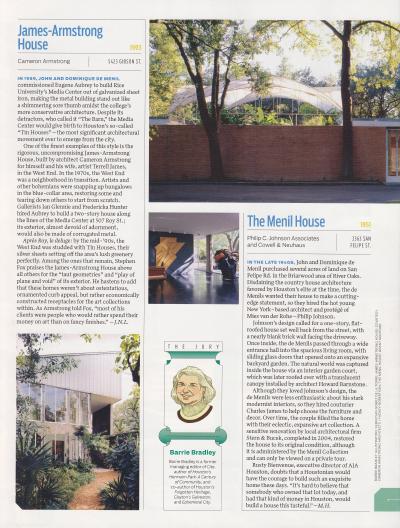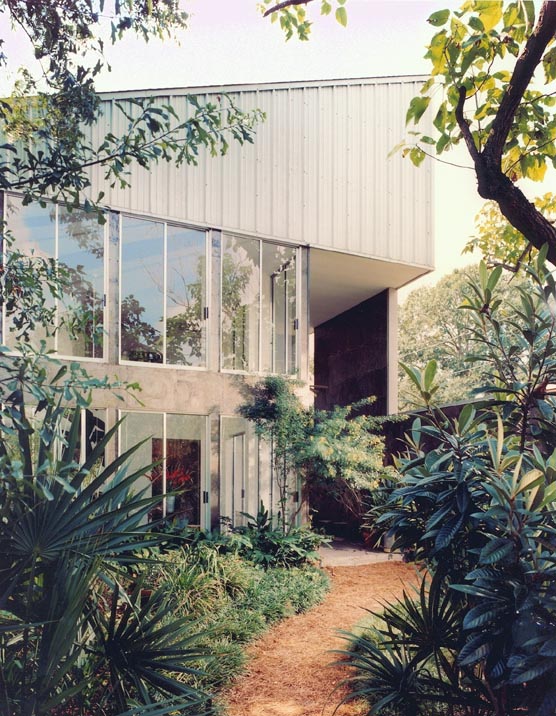go to... Houstonia
Dream Homes: Houston's Top 10 Houses
By John Nova Lomax & Michael Hardy, with selections by a panel comprising Rusty Bienvenue (Houston AIA), Barrie Bradley (author), Stephen Fox (historian), and James Evans (architect)
Houstonia Magazine, January 2014
"An insider's guide to the greatest houses in the city"


The 10 houses on our final list were built between 1847 and 2012 by architects both obscure and world-famous. Some are massive; some are modest. Some are still inhabited; some are now museums. There are Houston icons and hidden gems. The only thing these houses have in common, it seems, is their greatness according to one panel of experts. And while there’s surely no Platonic Form of housing greatness, we like to think that, to paraphrase former Supreme Court Justice Potter Stewart, all of us know greatness when we see it.

Houston’s first houses were so meager that an early traveler, navigating his way up Buffalo Bayou in 1837, didn’t even notice them, or the town, for that matter. “Just before reaching our destination a party of us, becoming weary of the steamer, took a yawl and concluded we would hunt for the city,” wrote Dr. John Washington Lockhart. “So little evidence could we see of a landing that we passed by the site and [ran] into White Oak Bayou, realizing that we must have passed the city when we struck the brush.”
When he finally backtracked, Lockhart discovered that the first Houstonians lived in rudimentary shacks; others, too poor to afford lumber, had erected tents. By the end of the year, however, the city had made astonishing progress, according to
Sam Houston: “On the 20th of January,” wrote the Republic of Texas president, “a small log cabin and 12 persons were all that distinguished it from the adjacent forests, and now there are upwards of 100 houses finished, and going up rapidly (some of them fine frame buildings).” Over the years, those “fine frame buildings” have given way to mansions, manors, and modernist showpieces, and yet there are some constants—the housing market is still booming, and people are still flabbergasted by the city’s capacity for growth.
But what makes a great home? Is it cutting-edge architecture? Size and expense? Livability? Those are the questions Houstonia recently posed to a panel of four local architecture experts, whom we assembled to help choose the 10 greatest homes that exist in Houston. Prior to that, we asked each panelist to submit a personal top 10 list, which we then compiled into a single long list of candidates—you can see the entire thing on our website, at houstoniamag.com—which we asked our jury, led by architectural historian and professor Stephen Fox, to discuss one by one. Some were quickly rejected; others received near-universal praise; still others provoked heated debate. By evening’s end, however, we had achieved rough unanimity.
The 10 houses on our final list were built between 1847 and 2012 by architects both obscure and world-famous. Some are massive; some are modest. Some are still inhabited; some are now museums. There are Houston icons and hidden gems. The only thing these houses have in common, it seems, is their greatness according to one panel of experts. And while there’s surely no Platonic Form of housing greatness, we like to think that, to paraphrase former Supreme Court Justice Potter Stewart, all of us know greatness when we see it. —Michael Hardy
[The process:] When we decided to put together our January feature on Dream Homes, we started by asking four local architecture experts to submit a list of their 10 favorite Houston domiciles. Several of the experts submitted more than 10 homes, while architectural historian Stephen Fox submitted two lists—one of his 10 favorite homes by practicing architects, and one of his 10 favorite homes by architects no longer practicing. In early November, the four experts gathered at the Houstonia house to go over their combined lists and discuss the relative merits of the included homes. Out of that meeting, a rough consensus emerged around 10 buildings.
Houstonia's Ten Most Important Homes:
1. Frame-Harper House (1960) by Neuhaus & Taylor • 430 Westminster Dr.
2. Sewall House (1926) by Cram, Goodhue, & Ferguson • 3456 Inwood Dr.
3. The Perf House (2011) by Logan and Johnson • 1134 Waverly St.
4. William Nash House (1907) by H.C. Cooke & Co. • 215 Westmoreland Ave.
5. James-Armstrong House (1993) by Cameron Armstrong • 5423 Gibson St.
6. Menil House (1951) by Philip C. Johnson Associates and Cowell & Neuhaus
7. Durst-Gee House (1960) by Bruce Goff • 323 Tynebrook Ln.
8. Bayou Bend (1928) by John Staub • 1 Westcott St.
9. St. Emanuel House (2009) by Ronnie Self • 3308 St Emanuel St.
10. The Kellum-Noble House (1847) Francis McHugh • Sam Houston Park, 1000 Bagby St.
go to... Jurors' Lists
James-Armstrong House (1993)
Cameron Armstrong • 5423 Gibson St.
In 1969, John and Dominique de Menil commissioned Eugene Aubrey to build Rice University’s Media Center out of galvanized sheet iron, making the metal building stand out like a shimmering sore thumb amidst the college’s more conservative architecture. Despite its detractors, who called it “The Barn,” the Media Center would give birth to Houston’s so-called “Tin Houses”—the most significant architectural movement ever to emerge from the city.
One of the finest examples of this style is the rigorous, uncompromising James-Armstrong House, built by architect Cameron Armstrong for himself and his wife, artist Terrell James, in the West End. In the 1970s, the West End was a neighborhood in transition. Artists and other bohemians were snapping up bungalows in the blue-collar area, restoring some and tearing down others to start from scratch. Gallerists Ian Glennie and Fredericka Hunter hired Aubrey to build a two-story house along the lines of the Media Center at 507 Roy St.; its exterior, almost devoid of adornment, would also be made of corrugated metal.

Après Roy, le deluge: by the mid-’90s, the West End was studded with Tin Houses, their silver sheets setting off the area’s lush greenery perfectly. Among the ones that remain, Stephen Fox praises the James-Armstrong House above all others for the “taut geometries” and “play of plane and void” of its exterior. He hastens to add that these homes weren’t about ostentatious, ornamented curb appeal, but rather economically constructed receptacles for the art collections within. As Armstrong told Fox, “most of his clients were people who would rather spend their money on art than on fancy finishes.” —J.N.L.